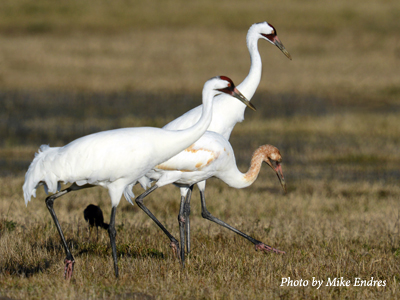 Parent-rearing, costume-rearing, “target” adults – these are all terms you may be hearing this fall as you follow the next chapter in Whooping Crane reintroduction in the eastern United States. This document addresses questions that you may have about the new rearing and release methods that we are implementing this year with our colleagues in the Whooping Crane Eastern Partnership.
Parent-rearing, costume-rearing, “target” adults – these are all terms you may be hearing this fall as you follow the next chapter in Whooping Crane reintroduction in the eastern United States. This document addresses questions that you may have about the new rearing and release methods that we are implementing this year with our colleagues in the Whooping Crane Eastern Partnership.
What is parent-rearing?
Parent-rearing is when a crane chick is raised by adult cranes. The adult cranes may be the chick’s biological parents, or an egg from another pair may be placed in the nest as it begins to hatch. This rearing method is in contrast to costume-rearing, in which chicks are raised by trained staff wearing a costume that hides the human form and keeps the chicks from imprinting on, or bonding with, people. This method of rearing is being used with captive Whooping Crane pairs that live at the International Crane Foundation and Patuxent Wildlife Research Center in Maryland.
How have the changes in the Whooping Crane rearing and release methods affected our breeding program this year?
The changes in the Whooping Crane Eastern Partnership’s rearing and release methods seek to limit the amount of time chicks spend with costumed staff, while emphasizing as much interaction as possible with adult Whooping Cranes (click here to learn more about these changes). To achieve this goal, our highest priority this year for the eastern migratory population is to focus on parent-rearing, which has resulted in three of our adult Whooping Crane pairs hatching and raising chicks without the use of costumed staff.
Prior to their first fall migration, the chicks are released in Wisconsin near wild Whooping Cranes. Our goal is for the adult birds to “adopt” or associate with the young birds and teach the chicks their migratory route. This release method has been tested in Wisconsin with Whooping Crane chicks raised by our partners at the Patuxent Wildlife Research Center with promising results.
How do we care for the parent-reared families at our headquarters?
The families are treated similar to the rest of our captive cranes in that they receive daily fresh food, water, and clean enclosures. Chicks receive routine health exams to ensure their proper development. Each family has a large water feature and natural vegetation in their yard where the parents can teach the young birds how to forage for food and roost in water. Aviculture staff minimize the disturbance to these families by using a remote camera to closely monitor the chicks’ development and family interactions.
How are the parent-reared chicks released?
Members of the Whooping Crane Eastern Partnership prepare for release by doing many hours of observations on “target” birds – those pairs or juvenile Whooping Cranes that will hopefully accept a young parent-reared bird into their company. A release pen is placed in the area where the target birds have been observed. The chick is then moved from the staging area enclosure in White River Marsh in southeast Wisconsin to the release pen, where further observations are made prior to release.
Are we tracking the parent-reared chicks after they are released?
Yes, staff from the International Crane Foundation, Operation Migration, Patuxent Wildlife Research Center, and the Wisconsin Department of Natural Resources are splitting duties observing the “target” adults – the birds that the chicks are placed with after release. We are also monitoring the chicks in their release pens to observe their interactions with the adults when the older cranes are near the pen. If the adult birds show positive interest in the chick over the course of 24-48 hours, the decision to release the chick into the wild will be made. We then continue to closely follow the chicks for the next week and will continue to monitor their movements along with the rest of the population as they prepare for fall migration.
What happens if adult Whooping Cranes do not adopt the parent-reared chicks?
If we don’t see positive signs of interaction between the chick and adults while the young crane is in the release pen, the chick may be relocated to another site with different adult birds. Once the chick is released, there is a chance it may not stay with the “target” birds. As with other releases the Whooping Crane Eastern Partnership has done in the fall, there are many Sandhill Cranes in the vicinity of all our release pens. The chicks may follow Sandhill Cranes and still gain the experience needed to correctly migrate south for the winter.
How many years will it take for us to know that this release method is successful?
We will know a little about the success of the release program within the first year as the chicks complete their first migrations, but the true test of success won’t be until the chicks mature and start to breed. Whooping Cranes reach breeding age at three; and it may take several years for the young birds to gain experience to successfully raise chicks to fledging. Therefore it may be five or more years after release before we know how the parent-reared birds fare in the wild.
Will the changes in the Whooping Crane rearing and release methods allow you to continue to contribute to the Louisiana reintroduction?
Our staff are continuing to costume-rear Whooping Crane chicks at our chick rearing facility for the Louisiana reintroduction. Due to the still small, but growing, size of the Louisiana flock – currently at approximately 40 birds – the protocols for raising chicks for reintroduction in this population continue to focus on costume rearing techniques that we have used successfully in the past.
